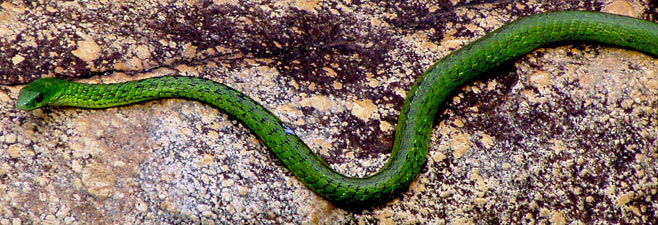|
Philothamnus angolensis (Angola green snake, Western
green snake)
Angolagroenslang [Afrikaans]
Life >
Eukaryotes
>
Opisthokonta >
Metazoa
(animals) > Bilateria > Deuterostomia >
Chordata >
Craniata > Vertebrata (vertebrates) > Gnathostomata (jawed vertebrates) >
Teleostomi (teleost fish) > Osteichthyes (bony fish) > Class:
Sarcopterygii (lobe-finned fish) > Stegocephalia (terrestrial vertebrates) >
Tetrapoda
(four-legged vertebrates) > Reptiliomorpha > Amniota >
Reptilia (reptiles) >
Romeriida > Diapsida > Lepidosauromorpha > Lepidosauria >
Squamata > Serpentes
(snakes) > Family: Colubridae > Subfamily:
Colubrinae > Genus:
Philothamnus
 |
|
Philothamnus angolensis (Angola green snake, Western
green snake), Manicaland, Zimbabwe. [G. Diedericks ©, from
SARCA Virtual Museum] |
Identification
The Angola green snake can be identified by the black skin
between its scales, its blue spots, round pupils, an excellent climbing ability
and a diurnal lifestyle. It grows to an average length of 1 meter and a maximum
length of 1.2 meters.
Distribution and habitat
Found in central Namibia, the Caprivi strip,
northern Botswana, eastern Zimbabwe, west Mozambique and the Mozambique / South
Africa border. Its favoured habitats are lowland forest and the edges of arid
savanna.
Food
Eats
birds, lizards (particularly chameleons) and
frogs.
Predators, parasites and disease
Eaten by other snakes (particularly vine snakes),
birds of
prey (particularly
secretary birds and
snake eagles).
Reproduction
Oviparous (egg-laying), usually lays between 4 and 8
eggs but may lay up to 16 eggs.
Longevity
Likely to have an average lifespan of
10 years.
Medical importance
Non-venomous and not dangerous to man.
Links
References
-
Broadley, D.G. 1983. FitzSimons' Snakes of Southern
Africa. Delta Books, Johannesburg.
-
Marais, J. 2004. A Complete Guide to Snakes of Southern Africa.
Struik Publishing, Cape Town.
|
